Basic Stratigraphy
Understanding how rock layers (beds) have been laid down and subsequently modified by forces within the earth (deformed) can tell us what sorts of events have been taking place over the time: movement of tectonic plates, mountain building, erosion, earthquakes. All of these leave their mark on the earth's rock layers.
The first step to sorting out this history of events is to understand how rock beds look when they are first deposited.
Depositional Rocks are rocks that are layered down onto a pre-existing surface. Examples include sedimentary rock (sandstone, mudstone, limestone) and many volcanic rocks (lava, pyroclastic flows). Most rocks of this type conform to a set of simple rules first stated by Nicolaus Steno in the mid 1600s.
|
Steno's Stratigraphic Principles
1) Rock-forming materials are layed down in flat, horizontal layers.
2) Rock-forming layers are laterally extensive.
3) In any sequence of parallel layers, the oldest layer is on the bottom of the sequence.
|
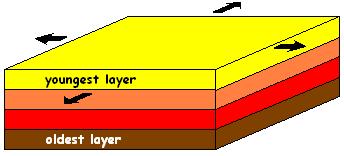 |
Any feature of a body of depositional rocks that does not match these principles, must be a result of deformation. These could include:
1) Non-horizontality
2) Abrupt termination of a rock layer
3) Rock layers cutting across another each other
Consideration of these principles allow a geologist to interpret what she or he sees on the ground in terms of both how the rock layers are configured below the ground and how they must have looked before the current ground surface was formed by erosion.
This is what we might see walking across the ground today. The ground surface is not horizontal, but tilts up to the right, perhaps at the foot of a small hill. Each colour stripe represents one of the rock layers in the diagram above.
The grey zones represent rock layers that were not part of the original yellow to brown block diagram above. |
This what we could infer about what is going on below ground level, based on what we learned from the map interpretation lesson. |
This is what we might infer about how the rocks would have looked after deformation, but before erosion to the current ground level. Yes, rocks do get deformed as severely as this, and more so!
With an understanding of Steno's principles, we can deduce that they would have been horizontal originally and subsequently deformed: folded (ductile deformation) and faulted (brittle deformation). |
|

|
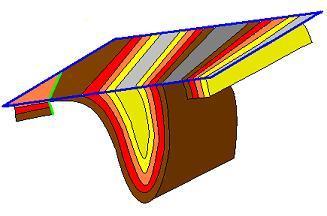
|
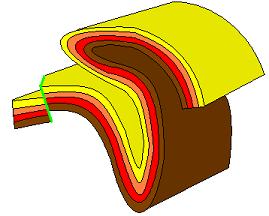
|
Non-depositional Rocks: These are rock for which the rock-forming material was forced into a pre-existing rock mass. In such cases, the nice stratigraphic principles of Steno do not usually apply, and it can be much harder to work out what sort of deformation has taken place since. We will leave this subject until you get to university (and there was much rejoycing)
Other Stratigraphic Principles
There are many other stratigraphic features that can help up figure out what events have happened over time and in what chronological order they have happened
1) Unconformities
These are gaps in the rock record during which: i) no material was deposited to form into rock, or ii) material was eroded away. There are three recognisable types of unconformity:
A) Angular Unconformity
Rock layers have different orientations on each side of the unconformity. This indicates a prolonged period of time during which material must have been buried and lithified into rock, deformed by folding or faulting, and finally uplifted and eroded. Only then could the rocks above the unconformity be emplaced.
B) Disconformity
Rock layers have the same orientation on either side of the gap. The unconformity may be recognized by different rock types or by an obvious erosion surface.
C) Nonconformity
This describes the juxtaposition of dissimilar rock types such as sandstone and granite, which do not form under the same conditions.
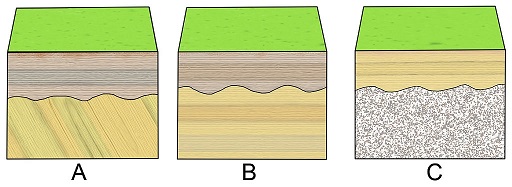
2) Cross Cutting
If a rock layer X or a fault cuts across rock layer Z, than both rock layer X and the fault must be younger than rock layer Z.
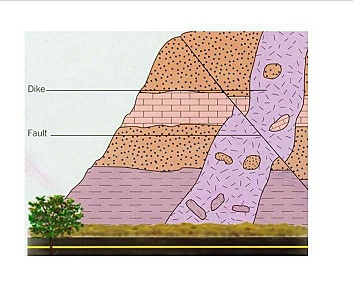
3) Intrusive Rocks
A volcanic rock that intrudes into other rocks must be younger than the rocks it intrudes into.
In these circumstances, the volcanic rock may show evidence of more rapid cooling (smaller crystals) around the its edge where it contacts the older, colder rocks. The older rocks may show evidence of having been altered by the heat of the volcanic material (pre-existing minerals modified into new ones).
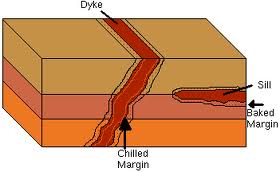
4) Inclusions
Where two rocks, X and Z, are in contact with each other and rock Z contains pebbles or other small bodies of X within it, then rock Z must be the younger of the two.

In image A, the granite must be older than the sandstone if pebbles of granite were around to be incorporated into the sandstone.
In image B, the sandstone must be older than the granite, because the sandstone must have been present already to have bits of it fall into the magma.
Making sure that you know which rock layers are younger
5) Faunal and Floral Succession
Biological evolution generally is a one-way process. Species evolve into new forms, persist for a certain period of time, then go extinct or evolve into new forms which replace the old ones. Certain fossils, index fossils, are more useful for this purpose. They are those that demonstrate rapid evolution, are easy to identify, can be found in a variety of environments, and were widely dispersed. We will discuss the procedure of relative dating using index fossils at a later point in the course.
6) Radiometric Dating
The radioactive decay of certain isotopes of elements found in common minerals into elements not found in those same minerals when they first form, can be used as a means of absolute dating. We will discuss this procedure at a later point in the course as well.
Back



